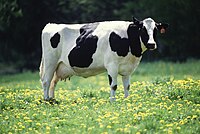
Photo from wikipedia
Metabolic consequences of an energy and protein rich diet can compromise metabolic health of cattle by promoting a pro-inflammatory phenotype. Laminitis is a common clinical sign, but affected metabolic pathways,… Click to show full abstract
Metabolic consequences of an energy and protein rich diet can compromise metabolic health of cattle by promoting a pro-inflammatory phenotype. Laminitis is a common clinical sign, but affected metabolic pathways, underlying pathophysiology and causative relationships of a systemic pro-inflammatory phenotype are unclear. Therefore, the aim of this study was to elucidate changes in metabolome profiles of 20 months old Holstein bulls fed a high energy and protein diet and to identify novel metabolites and affected pathways, associated with diet-related laminitis. In a randomized controlled feeding trial using bulls fed a high energy and protein diet (HEP; metabolizable energy [ME] intake 169.0 ± 1.4 MJ/day; crude protein [CP] intake 2.3 ± 0.02 kg/day; calculated means ± SEM; n = 15) versus a low energy and protein diet (LEP; ME intake 92.9 ± 1.3 MJ/day; CP intake 1.0 ± 0.01 kg/day; n = 15), wide ranging effects of HEP diet on metabolism were demonstrated with a targeted metabolomics approach using the AbsoluteIDQ p180 kit (Biocrates Life Sciences). Multivariate statistics revealed that lower concentrations of phosphatidylcholines and sphingomyelins and higher concentrations of lyso-phosphatidylcholines, branched chain amino acids and aromatic amino acids were associated with an inflammatory state of diet-related laminitis in Holstein bulls fed a HEP diet. The latter two metabolites share similarities with changes in metabolism of obese humans, indicating a conserved pathophysiological role. The observed alterations in the metabolome provide further explanation on the underlying metabolic consequences of excessive dietary nutrient intake.
Journal Title: Scientific Reports
Year Published: 2021
Link to full text (if available)
Share on Social Media: Sign Up to like & get
recommendations!